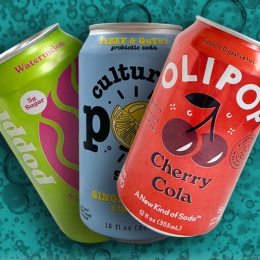Our guide to the Nutrition Facts label
Most foods now disclose added sugars and carry an improved Nutrition Facts label. Nutrition Action’s publisher, the Center for Science in the Public Interest, has pushed for both since 1999.

Vitamins & minerals
- Vitamin D, calcium, iron, and potassium must be listed on all labels since they’re linked to major health problems.
- If a food adds—or makes a claim about—any other nutrient, it must also be listed. (Labels can show other vitamins, but it’s voluntary. Don’t see them? That may just mean that the company has chosen not to draw attention to them.)
Serving sizes
- Some serving sizes expanded to reflect how much the FDA calculates we typically eat. A few key changes:
- ice cream went from ½ to 2/3 cup.
- soda, tea, coffee, and water jumped from 8 to 12 oz.
- most cereals went from 1 oz. to nearly 1½ oz. (40 grams).
- muffins and bagels doubled, from 2 to nearly 4 oz. (110 grams).
- Whatever the food, the size of the package also matters. Less than two servings per container? A “serving” is now the whole package. Two to three servings? Most labels have to tack on a second column that gives Nutrition Facts for the entire package.
Added sugars
- “Added Sugars” means sugars that come from sweeteners (cane sugar, high-fructose corn syrup, agave, honey, etc.).
- Why the “Includes”? The “Total Sugars” line right above it includes the naturally occurring sugars in milk, fruit, tomatoes, carrots, etc., plus any added sugars.
- 10 grams of added sugars is 20% of the Daily Value (50 grams). (A 30-gram DV would be better, but it’s not up to us. A healthy diet leaves little room for sugar’s empty calories. See Nov. 2020.)
Milligrams, etc.
- Vitamins and minerals now list their amounts in mg (milligrams), mcg (micrograms), etc., not just as the “% Daily Value.” That helps if you need less or more than the DV.
- Vitamin D is now listed in mcg, not IU. (1 mcg = 40 IU.)
Daily Values
- To match the latest advice for healthy bones, the DV for vitamin D doubled, from 10 to 20 mcg (800 IU). That’s what adults over 70 need. Adults 70 and under need only 15 mcg a day.
- The calcium DV rose from 1,000 to 1,300 mg. But premenopausal women and men up to age 70 still need only 1,000 mg a day. Postmenopausal women and men over 70 need 1,200 mg. (The 1,300 mg is for children age 9 to 18.)
Fiber: What counts?

Fruits, vegetables, beans, and whole grains are rich in intact fiber that may help prevent constipation, heart disease, and more. But the “Dietary Fiber” number on the Nutrition Facts label can also include processed fibers like inulin, polydextrose, soluble corn fiber, or any others that the FDA says have at least one health benefit.
The catch: The labels don’t tell you which benefit sealed the deal. Does the fiber boost regularity? Lower your cholesterol? Do something else you may not care about?
For example, a Quest Cookies & Cream Protein Bar has 15 grams of fiber—just over half the Daily Value. But it’s largely soluble corn fiber. Its benefit? It boosts calcium absorption.
Beans, bran, and other real foods have a mix of intact fibers with a mix of benefits. Don’t expect bars, shakes, or other foods with processed fibers to match them.
What's your serving?

The serving size for Target’s Favorite Day Sliced Blueberry Mini Bagels is the number that comes closest to the FDA’s new, larger serving size (110 grams).
That’s three mini bagels.
Is that a recommendation? Nope.
By law, the FDA must set serving sizes that reflect what Americans eat, not what they should eat. And a typical U.S.-size bagel has about 4 servings of grain—enough for a full day.
How much should we eat? A single mini bagel comes pretty close to a recommended serving of grain.
Some ice cream bars and pops also call two or three bars a serving. Ignore them.
In contrast, the FDA’s serving size for pasta is surprisingly small—2 oz., which is just 1 cup cooked! If you eat more, multiply.
Juice sugars

A 15 oz. Naked Protein Greens shake has a whopping 390 calories and 50 grams of total sugars.
How many of those 50 grams count toward your 50-gram Daily Value for added sugars? None, according to the “0%” on the label.
Sugars from juice don’t count as “added” because they occur naturally in the fruit. Naked’s first ingredient: apple juice. (It also has pineapple juice, fruit purées, soy and whey proteins, and a smidgen of greens.) Just don’t kid yourself. Juice isn’t a health food.
Drinking juice is more likely to lead to unhealthy weight gain than munching on whole fruit.
That’s because liquids don’t curb your hunger like solid foods that you chew. (You’d have to eat 2½ apples to get Naked’s 50 grams of sugars. Talk about filling!)
The bottom line: Limit added sugars and juice sugars.
Whited out

Why is there often no “Added Sugars” line on sweeteners like white or brown sugar or honey?
Thank lobbyists for the honey and maple syrup industries. An “Added Sugars” line, they argued, would make it look like companies had added sugar to their honey or syrup. So the FDA lets sweetener labels omit the words “Added Sugars.”
But labels still count all of a sweetener’s sugars when they calculate the %DV—that is, how much of a day’s added sugars you’re getting.
Topics
Continue reading this article with a NutritionAction subscription
Already a subscriber? Log in
More shopping guides
Store-bought pre-seasoned tofu: Which is best?
Healthy Eating

How to find a healthy ice cream bar or frozen treat
Healthy Eating

How to find a healthy dairy or plant-based cheese
Healthy Eating

Can sodas help your gut health?
Healthy Eating

How to choose the best plant-based burgers & beyond
Healthy Eating


